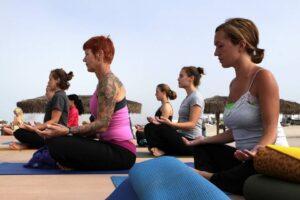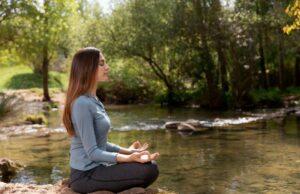Meditation is a centuries-old practice that has been shown to reduce stress, increase focus, and improve overall mental and physical well-being. Despite its numerous benefits, many people find it challenging to get started with meditation, often because they are not sure where to begin or what to expect. In this blog post, we will explore some basic steps and techniques to help you get started with mindfulness meditation.

Mindfulness is a practice that can help individuals tune into the present moment, reducing stress and increasing overall wellbeing. As the pace of life continues to quicken, it's not surprising that more and more people are feeling overwhelmed and anxious. Between balancing work, personal relationships, and technology, it can be challenging to find a sense of peace and calm in our daily lives.
In recent years, meditation has emerged as a highly effective tool for managing anxiety and stress. As more and more people suffer from stressful daily lives, the interest in meditation for relief has also grown. While meditation is often considered a spiritual practice, it's important to understand that it's much more than that. Meditation is a proven approach to enhancing overall mental and physical health, and a useful technique to up the serenity level of your life.
Although it's a relatively simple concept, starting Mindfulness Meditation can feel overwhelming at first. Where do you begin? What are the benefits? In this blog post, we'll explore the basics of Mindfulness Meditation and offer tips for getting started. Whether you're a busy professional looking to reduce distractions or simply hoping to boost your mental acuity, practicing mindfulness can benefit a broad range of individuals. From basic breathing exercises to comprehensive meditation sessions, we'll share practical advice for incorporating mindfulness meditation into your daily routine. By prioritizing mindfulness and incorporating it into your lifestyle, you can reap the benefits of a clearer, more focused, and more serene mind.
Set aside a specific time each day to meditate
Mindfulness Meditation(MM) is a wonderful form of self-care that can help you reduce stress, improve focus, cultivate inner peace and live your life with more intention and purpose. If you're new to meditation, it can be a bit daunting to know where to begin. One of the simplest and most effective ways to start is by setting aside a specific time each day to meditate. Whether it's five minutes or 30 minutes, choose a time that works for you and make it a non-negotiable part of your daily routine. By consistently showing up for yourself in this way, you'll create a sacred space for peace and calm to thrive. Remember, meditation is not about perfection, but rather the process of showing up and being present in the moment. The key is to give yourself permission to prioritize your own needs and to create a space where you can connect with your inner self. So go ahead, start small, and enjoy the transformative power of stillness and serenity.
Find a comfortable and quiet space
Congratulations on taking the first step towards building a consistent meditation practice! One of the keys to successful meditation is finding a comfortable and quiet space to meditate in. Choose a location where you feel at ease and where you won't be disturbed. This could be a sacred corner of your home, a bench in a park, or even a meditation center. Once you have found that special place, make it your own. Begin by decluttering your immediate surroundings to eliminate any unnecessary items that may cause visual or mental clutter, then add some inspiring objects, such as candles or flowers, and maybe some soft lighting. With a comfortable and quiet space, you'll be able to dive deeper into your meditation practice, free from distractions and fully focused on achieving inner peace. You can also incorporate calming scents such as lavender, eucalyptus or peppermint to further enhance your space. Remember that this environment doesn't have to be fancy or expensive; the most important aspect is to create a space that allows you to let go of stress and focus on being present in the moment. So find your spot and get ready to begin your journey towards a more centered, peaceful self.
Focus on your breath

MM can be the ultimate game-changer in your journey towards inner peace and happiness. It can help you tune out the noise of the world and find your center amidst the chaos. However, getting started with meditation can be intimidating. If you are new to the practice, consider starting with something as simple as focusing on your breath. Take a deep inhale, and then exhale slowly. Repeat this process, and as you do, let your mind focus solely on the sensation of the air moving in and out of your lungs. This mindfulness technique can help you calm your racing thoughts and bring you closer to a sense of calm and relaxation. So, take a deep breath and allow yourself to be present in the moment. You've got this.
Over time, you can build up this practice and even incorporate mindful breathing into your daily routines, such as while walking or doing chores. So take a deep breath and get started on your path to a more mindful and peaceful life.
Observe your thoughts without judgment
Welcome to the world of MM, where instead of reacting to your thoughts or trying to push them away, you simply let them come to the surface and become aware of them. When you observe your thoughts without judgment, you can start to understand your patterns of thinking and develop a deeper awareness of your emotions. Remember, the goal of meditation is not to stop your thoughts, but rather to acknowledge them and let them pass by like clouds in the sky. You'll learn to identify patterns of thought that may be holding you back or causing you distress, and you'll become more aware of the physical sensations that accompany different emotions. With practice, you'll be able to recognize when you're experiencing issues like stress or anxiety and take steps to manage those feelings before they become overwhelming. Over time, you will experience a greater sense of clarity, peace, and inner wisdom. So take a deep breath, relax your mind, and enjoy the benefits of this life-changing practice.
Let go of expectations
One key aspect of MM to keep in mind is to let go of your expectations. It can be tempting to approach MM with a specific goal or outcome in mind, but this can actually get in the way of your practice. Instead, try to approach it with a sense of openness and curiosity, allowing yourself to simply be in the present moment without any particular expectations. This can help you to cultivate a greater sense of ease and relaxation, and can also help you to develop a more mindful and accepting attitude towards your thoughts and emotions. Remember, the goal isn't necessarily to achieve any particular outcome, but rather to simply be present with whatever arises in the moment. So take a deep breath, let go of your expectations, and see where your meditation practice takes you.
Allow yourself to feel whatever arises

MM is all about being aware of the present moment, and allowing yourself to simply be. One of the most important things to remember as you start your meditation journey is to allow yourself to feel whatever arises. This means that you don't need to try and suppress or control your thoughts and emotions. Instead, simply observe them without judgement, and let them pass by like clouds in the sky. While it may be tempting to try and force yourself to feel a certain way or push away uncomfortable feelings, this only creates more resistance and tension. Instead, trust that whatever comes up during your meditation is a necessary part of your experience and will help you grow and evolve in your practice. Remember, there is no right or wrong way to meditate, so trust your intuition and allow yourself to be fully present in the moment.
Make time for daily gratitude
Make time during your for gratitude. When you focus on gratitude, you train your mind to find the good in everyday life. You'll begin to appreciate the small things that often go unnoticed and you'll feel happier as a result. Each day take a few minutes to think about what you're thankful for, write it down, and reflect on it throughout the day. It could be something as simple as a cup of coffee in the morning or a call from a friend. Showing gratitude daily can help you develop a more positive outlook on life and help you focus on what truly matters in your life. Start small and stay consistent, you'll begin to feel a shift in your perspective and see the world in a whole new light.
Commit to a regular practice
If you want to reap the many benefits of MM, you need to commit to a regular practice. This means setting aside time each day to sit in silence and focus on your breath. It doesn't have to be a long time, even just 10 minutes a day can make a difference. The key is consistency, so try to incorporate your meditation practice into your daily routine. Maybe you can meditate first thing in the morning, or during your lunch break, or before bed. Whatever works for you, stick to it. It may take some time to develop the habit, but once you do, you'll find that MM becomes a natural and essential part of your daily routine. Remember, it's not a one-time event, it's a lifelong journey, so be patient with yourself and enjoy the process of self-discovery and inner peace that comes with a regular observance.
Explore different types of meditation
One of the best things about meditation is the variety of techniques available to suit different preferences and situations. If you're new to meditation or looking to refresh your practice, it's worth exploring different types of meditation to find what works best for you. While we concentrate here on MM, there are other techniques e.g. loving-kindness meditation, that can help you cultivate a calmer, more focused mind and better manage stress and anxiety. By trying out different styles of meditation, you can discover which approach resonates with you and tailor your practice to your needs. Remember, don't be afraid to experiment and have an open mind. With patience, consistency, and a willingness to learn, you can unlock the transformative power of meditation and improve your overall well-being.

Connect with your inner wisdom
In your journey to practice meditation and reap its benefits, connecting with your inner wisdom is a crucial step that cannot be overlooked. This is because meditation provides a space within which we can tap into our deepest selves, and cultivate an awareness of our inner voice. That voice is often drowned out by the noise of everyday life, but if we make a conscious effort to sit in stillness, we can learn to listen to it more closely. It is from this place of deep wisdom that we can access all of the answers and insights we need to live more fulfilling lives. So take a moment to connect with yourself, trust in your own truth, and let your inner wisdom lead the way. Remember, the more regularly you practice meditation, the more your ability to access your inner wisdom will strengthen and grow.
Stay patient and be kind to yourself
Remember to stay patient and be kind to yourself. The benefits of MM are not usually immediate, and it can take time and consistent practice to achieve noticeable results. It's easy to become frustrated or discouraged if you don't see the changes you were hoping for right away. However, approaching your practice with patience and self-love allows you to let go of these feelings and to appreciate the journey itself. Trust the process and know that your efforts are not wasted, even if you don't see the results right away. Treat yourself with compassion and give yourself the time and space to explore the many benefits that meditation can bring to your life. Remember, meditation is not a destination – it's a journey of self-discovery, and being kind to yourself along the way is the key to unlocking its full potential.
Develop a positive attitude towards everyday challenges
Developing a positive attitude towards everyday challenges is a crucial step here. Cultivating a positive mindset can make difficult situations seem more manageable and help you embrace the present moment with an open and curious mind. You can start by recognizing unhelpful thought patterns that may be holding you back, such as negative self-talk or a tendency to catastrophize small setbacks. Instead, try reframing challenges as opportunities for growth and learning. Whether you're dealing with a difficult work project, a personal conflict or a physical ailment, approach it with a sense of curiosity and a willingness to learn from the experience. Remember, mindfulness is not about trying to eliminate stress or difficulties from your life, it's about developing the skills and mindset to cope with them in a way that promotes well-being and inner peace. So the next time you face a challenge, take a deep breath, focus on the present moment and approach it with a positive attitude.
Visualize a safe place and allow yourself to relax
Visualizing a safe place is a powerful technique that can help you relax and feel more at ease. You can use this technique during MM to help reduce anxiety and promote a sense of inner peace. Take a few deep breaths and focus on your breath. Then, begin to visualize a safe place in your mind. This could be a beach, a forest, a mountain, or any other place that makes you feel calm and peaceful. Allow yourself to fully immerse in this safe place, using your senses to imagine the sights, sounds, and smells. Take your time and explore this safe place, allowing yourself to relax and let go of any tensions or worries.
Take a few moments to appreciate yourself and your efforts
It's important to take a few moments to appreciate yourself and your efforts. Anxiety can often make us feel like we're not doing enough, or that we're not good enough. But , you are doing your best, so be proud of it. Reflect on all the hard work you've put in, and all the progress you've made. Be kind to yourself, and celebrate even the smallest accomplishments. Just remember, healing is not always a straight line, but every step forward is a victory. By taking the time to appreciate yourself and your efforts, you'll be building a stronger foundation of self-love and confidence that will help you overcome your anxiety.
Bonus: Stay connected to nature
One of the most important principles of mindfulness is staying connected to nature. So while you might do your meditations indoors at home – it is important for your wellbeing to add outdoor activities to your schedule. We often get so caught up in our busy lives and technology that we forget to take a step back and appreciate the beauty around us. Spending time in nature can bring a sense of calm and tranquility that is hard to find elsewhere. Even if it's just a walk in the park or a hike in the woods, make sure to take in the sounds, smells, and sights around you. By embracing all that nature has to offer, you can develop a greater sense of awareness and appreciation for the world we live in. So, take a moment to unplug and connect with the natural world around you. Trust us, it's worth it.
Conclusion
Mindfulness Meditation is a simple yet powerful way to promote relaxation, reduce stress and anxiety, and achieve inner peace. Even if you're new to MM, there are plenty of resources available to help you get started, from guided meditation apps to local classes. Remember, consistency is key, so try to set aside some time each day to practice. With patience and persistence, you'll soon discover the many benefits of this ancient practice and find a sense of calm and balance in your daily life.
Thich Nhat Hanh: The Miracle of Mindfulness: An Introduction to the Practice of Meditation (1975) - Thich Nhat Hanh, a renowned Zen master and mindfulness teacher, shares practical tips and insights on incorporating mindfulness into daily life. This book is a classic and accessible introduction to mindfulness meditation, suitable for beginners and experienced practitioners alike.
Bhante Henepola Gunaratana: Mindfulness in Plain English (1994) - This book offers a clear, concise, and straightforward guide to mindfulness meditation. Written by a respected Buddhist monk and scholar, it covers the basics of mindfulness practice, common misconceptions, and practical advice for developing a consistent meditation routine
Jon Kabat-Zinn: Full Catastrophe Living: Using the Wisdom of Your Body and Mind to Face Stress, Pain, and Illness (1990) - Jon Kabat-Zinn, the founder of the Mindfulness-Based Stress Reduction (MBSR) program, presents a comprehensive guide to using mindfulness meditation for managing stress, pain, and illness. This book combines scientific research with practical exercises and is an excellent resource for those interested in the therapeutic applications of mindfulness meditation.
More Posts for Serenity
 | Steve Cato is a PhD-level scientist who brings a strong scientific perspective to the study of mind improvement. |
Semantically Related Posts
In traditional Buddhist and Hindu practices, the lotus position is believed to promote proper energy flow through the body and maintain a stable, grounded posture during meditation. Sitting cross-legged can help keep the spine erect, allowing for better focus and concentration. The lotus or half-lotus position may not be comfortable or accessible for everyone, so it's important to find a comfortable seated position that works best for you.
These traditional positions and gestures are rooted in religious and spiritual practices, it is not necessary to adopt them to experience the benefits of mindfulness meditation. What's most important is finding a comfortable posture that allows you to remain alert and focused. This could be sitting on a cushion, a chair, or even lying down if necessary. The key is to ensure your spine is straight, and your body is relaxed but not slouching.
Improved focus and concentration during meditation sessions.
Increased awareness of your thoughts and emotions without getting caught up in them.
Enhanced ability to manage stress and anxiety.
Greater sense of inner peace
Explore different types of meditation, such as loving-kindness meditation, body scan meditation, or mantra meditation, and see which resonate with you.
Integrate mindfulness into your existing spiritual practices, such as prayer, yoga, or contemplative reading.
Be open to learning from various meditation traditions and approaches, as each can offer unique insights and perspectives.
Remember to maintain a sense of curiosity and openness when experimenting with different techniques, and give yourself the freedom to adapt and modify your practice as needed.
Acknowledge the distraction without judgment. Recognize that it's natural for your mind to wander and gently bring your focus back to your breath or your chosen meditation object.
Find a comfortable and quiet space to meditate, free from external distractions.
Experiment with different times of the day to meditate, as you may find it easier to focus during specific periods.
If you're consistently distracted by a specific thought or concern, set aside some time to address it outside of your meditation practice.
Remember that distractions are a part of the meditation process, and with consistent practice, you'll become better at managing them over time.
Choose a comfortable position that works for you, whether it's sitting in a chair, lying down, or using props like cushions or blankets for support.
Focus on your breath or another aspect of your experience that is accessible to you, such as the sensations in your body or the sounds around you.
If you find it difficult to sit still for extended periods, consider practicing shorter meditation sessions or try incorporating mindfulness into your daily activities.
Consult with a healthcare professional or a meditation instructor with experience working with people with disabilities to help you find the best approach for your needs.
 | Using Positive Affirmations to Improve your Life | How to Create and Achieve SMART Goals |  |















